Ganesh Chaturthi Traditions: From Pooja to Prasadam
Ganesh Chaturthi, often referred to as Vinayaka Chaturthi, stands as one of the most revered and cherished Hindu festivals. This grand celebration, dedicated to Lord Ganesha, the elephant-headed deity, holds a unique place in the hearts of millions around the world. Its significance extends far beyond just religious observance; it symbolizes the essence of new beginnings, the removal of obstacles, and the joy of togetherness.
At the heart of Ganesh Chaturthi lies Lord Ganesha, the beloved and worshipped elephant-headed god of wisdom, prosperity, and good fortune. Lord Ganesha is revered as the "Vighnaharta" or the remover of obstacles, making him the first deity to be worshipped before any other Hindu god or goddess. His presence is believed to bring blessings, success, and protection to homes and businesses.
The purpose of Ganesh Chaturthi is multifaceted. It marks the birthday of Lord Ganesha and is observed with great fervour to seek his divine blessings. Devotees believe that invoking Lord Ganesha at the beginning of any endeavour ensures its smooth flow and success. Moreover, this festival fosters a sense of unity and community as families and neighbourhoods come together to install Ganesha idols in their homes and localities.
As we delve deeper into the traditions of Ganesh Chaturthi, we'll uncover the beautiful rituals, customs, and sweet offerings that make this celebration so special. Join us on this journey of devotion, culture, and the delightful prasadam that adds a sweet touch to this auspicious festival.
Ganesh Idol Installation
Significance of Bringing Home a Ganesha Idol
The act of bringing home a Ganesha idol during Ganesh Chaturthi carries profound significance. Lord Ganesha is revered as the harbinger of good fortune, wisdom, and success. By inviting him into our homes, we seek his divine presence to bless our lives and endeavours.
The choice to install a Ganesha idol at home signifies our readiness to embrace new beginnings with enthusiasm and positivity. Lord Ganesha is also known as the "Vighnaharta," the remover of obstacles. Hence, the presence of his idol is believed to eliminate all the obstacles, hurdles and challenges from our path, ensuring a smooth journey towards our goals.
Rituals and Customs During Idol Installation
The installation of the Ganesha idol is a sacred and joyous and auspicious occasion. The following rituals and customs are typically observed:
-
Pranapratishtha: This ritual involves infusing life into the idol, making it a divine representation of Lord Ganesha. Mantras and prayers are chanted during this process, invoking the deity's presence.
-
Sankalpa: Devotees make a formal resolution (sankalpa) to worship Lord Ganesha with devotion and dedication throughout the festival.
-
Ganesh Pooja: The idol is bathed with water, milk, yoghurt, honey, and other auspicious liquids. It is then adorned with fresh flowers and offered various sweets and fruits, including the beloved modak, symbolizing the sweetness of life.
-
Lighting of Lamps: Traditional oil lamps (diyas) or candles are lit to create a sacred atmosphere and to illuminate the idol.
-
Aarti: Devotees perform aarti by waving a plate with a lit lamp in a circular motion in front of the idol while singing hymns and songs in praise of Lord Ganesha.
-
Devotional Songs and Bhajans: Throughout the installation, devotional songs and bhajans (religious hymns) dedicated to Lord Ganesha are sung, enhancing the spiritual atmosphere.
The installation of the Ganesha idol is a deeply spiritual and joyous occasion, symbolizing the welcoming of divine grace and blessings into the home. It sets the stage for the days of devotion and celebration that follow during Ganesh Chaturthi.
Ganesh Pooja
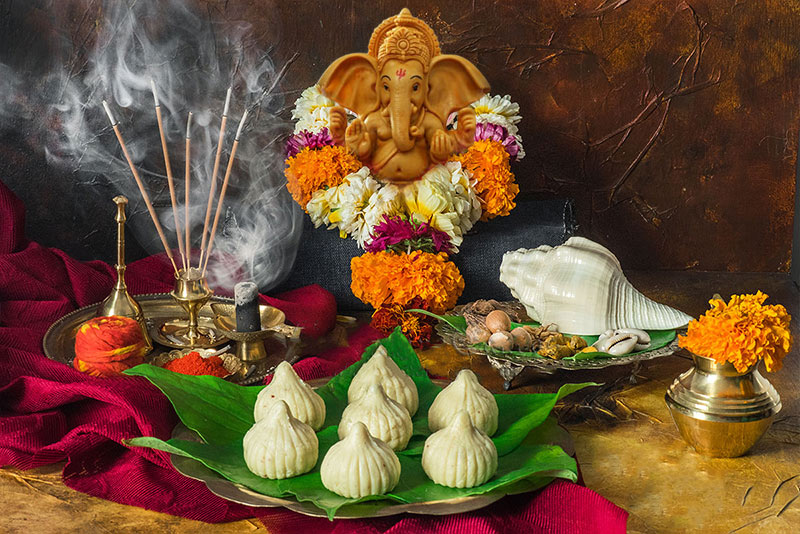
Ganesh Pooja is the heart of the Ganesh Chaturthi celebration, a deeply spiritual and ritualistic ceremony that involves various symbolic acts of devotion and reverence. Here, we will detail the step-by-step process of Ganesh Pooja, highlighting the significance of each ritual and the role they play in this sacred ceremony.
A. Offering of Flowers and Incense
-
Preparation: Before commencing the Pooja, devotees ensure they are clean and wear clean clothes. The sacred space where the Ganesha idol is placed is tidied and decorated with flowers and rangoli (coloured patterns).
-
Ganesha Pratima (Idol) Invocation: The Pooja begins with the invocation of Lord Ganesha. Devotees offer fresh flowers, usually jasmine, marigold, or roses, to the idol. Flowers symbolize purity, beauty, and devotion.
-
Incense Offering: Incense sticks are lit and waved in front of the idol. The fragrance of incense is believed to purify the surroundings and create a spiritually uplifting atmosphere.
B. Aarti (Ritual of Waving Lamps)
-
Lighting the Lamp: Aarti is a ceremonial act of waving a lit lamp in front of the idol. The lamp, often filled with ghee (clarified butter), represents the removal of darkness and the enlightenment of the soul.
-
Circular Motion: While singing devotional songs or bhajans dedicated to Lord Ganesha, the devotee holds the lit lamp in a circular motion in front of the idol. This symbolizes the cyclical nature of creation, preservation, and dissolution.
-
Ringing of Bells: Devotees may also ring bells during the Aarti, which is believed to ward off negative energies and create a divine resonance.
C. Modak (Sweet Dumpling) Offering
-
Significance of Modak: Modak, a sweet dumpling, holds immense significance during Ganesh Pooja. It is believed to be Lord Ganesha's favourite sweet and symbolizes the sweetness of life and the rewards of devotion.
-
Offering Modak: Devotees lovingly offer modaks to the idol. Some may also distribute modaks as prasadam (blessed food) to those present during the Pooja.
D. Emphasis on Devotion and Symbolism
Throughout the Ganesh Pooja, the key emphasis is on devotion and symbolism. Each ritual and offering carries a deeper meaning, reflecting the devotee's reverence and faith in Lord Ganesha. The Pooja serves as a profound expression of gratitude and an opportunity to seek the deity's blessings for wisdom, success, and the removal of obstacles in one's life journey. It fosters a deep spiritual connection between the devotee and the divine, creating a sense of peace and fulfilment.
Cultural and Traditional Aspects
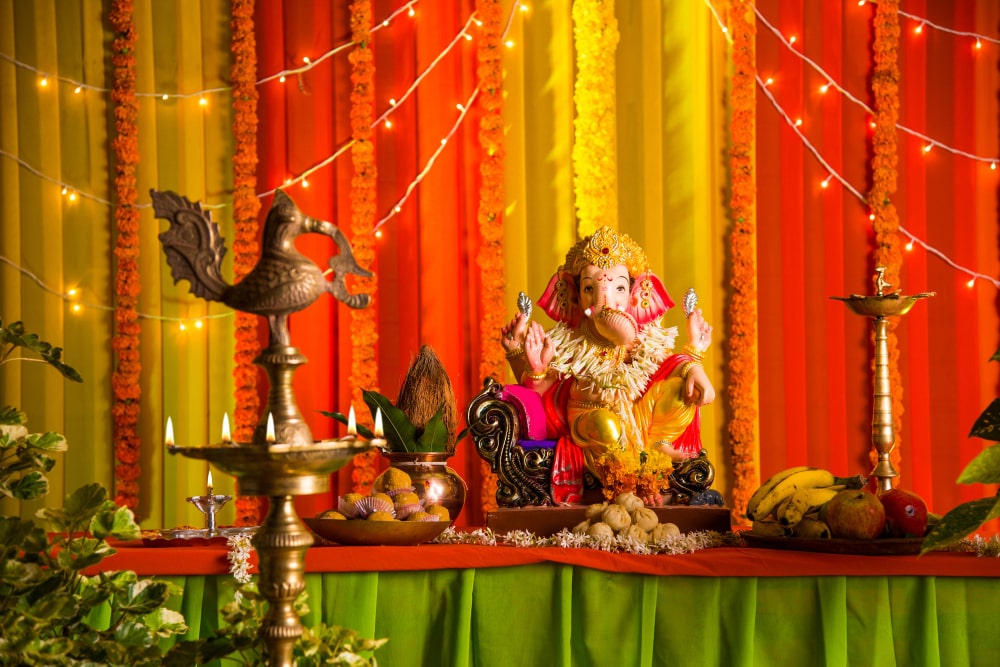
Ganesh Chaturthi is a festival that encapsulates the rich tapestry of Indian culture and traditions. Celebrated with great zeal and fervour across the country, it also exhibits regional variations and unique customs that add to its diverse charm.
Regional Variations in Ganesh Chaturthi Celebrations
-
Maharashtra: In Maharashtra, Ganesh Chaturthi is celebrated with immense grandeur and enthusiasm. Public processions with beautifully crafted idols are a common sight. The immersion of idols in water bodies like the Arabian Sea is a hallmark of this celebration.
-
Karnataka: In Karnataka, the festival is known as "Gowri Ganesha Habba." It involves the worship of Goddess Gowri, followed by Lord Ganesha. Married women observe this festival to seek blessings for their families.
-
Tamil Nadu: Ganesh Chaturthi, or "Vinayaka Chaturthi," is marked by decorating homes with kolams (rangoli), offering special neivedyam (offerings), and reciting hymns dedicated to Lord Ganesha.
-
Andhra Pradesh: The festival is celebrated as "Vinayaka Chavithi." It often includes the crafting of eco-friendly clay idols and recitation of the "Vinayaka Vrata Kalpam," a religious text.
-
Gujarat: In Gujarat, the festival coincides with the nine-day Navratri festival. The installation of Ganesha idols is accompanied by traditional Garba dance performances.
-
Goa: Ganesh Chaturthi, known as "Chavath," is celebrated with family gatherings and the preparation of traditional Goan sweets. Devotees immerse the idols in local rivers or the sea.
Anecdotes and Stories
-
The Tale of Lord Ganesha's Birth: One of the most beloved stories associated with Ganesh Chaturthi is the tale of Lord Ganesha's birth. It tells how Goddess Parvati created Ganesha from the dirt and oils of her body, leading to his unique appearance with an elephant head.
-
The Competition Between Ganesha and Kartikeya: Another popular legend recounts the competition between Lord Ganesha and his brother Kartikeya to circumnavigate the world. Ganesha, using his wisdom, circled his parents, symbolizing the universe's boundless nature, and won the competition.
-
The Miracles of Chaturbhuj Temple: The Chaturbhuj Temple in Orchha, Madhya Pradesh, is famous for a four-armed idol of Lord Ganesha. Legend has it that when Emperor Akbar attempted to remove one arm, a series of natural disasters struck the area. The arm was restored, and peace was regained.
-
Lokmanya Tilak's Role: The freedom fighter Lokmanya Tilak played a pivotal role in transforming Ganesh Chaturthi into a public festival during the colonial era. He saw it as a means of fostering unity and patriotic fervour among the masses.
These cultural and regional nuances, along with the delightful stories and legends, add depth and diversity to the celebration of Ganesh Chaturthi. It's a festival that transcends geographical boundaries, bringing people from all walks of life together to honour Lord Ganesha and the rich cultural heritage of India.
Prasadam Preparation
Prasadam, also known as prasad or prasada, holds a special place in Hindu religious and spiritual practices. It is a term used to describe food, sweets, or any edible offering that has been sanctified and blessed by the divine during religious ceremonies and rituals. Prasadam is believed to carry the grace and blessings of the deity to whom it has been offered. It is an integral part of Hindu worship and devotion, symbolizing the connection between the worshipper and the divine.
How Prasadam Is Considered Sacred and Blessed by the Deity
Prasadam is considered sacred and blessed by the deity for several reasons:
-
Divine Offering: When food is offered to a deity during a religious ceremony, it is believed that the deity accepts the offering and infuses it with its divine presence and blessings.
-
Purity and Sanctification: The food offered as prasadam undergoes a purification process through rituals and mantras. This process is thought to cleanse the food of any impurities and make it fit for consumption by devotees.
-
Acceptance of Devotion: Offering prasadam is a gesture of devotion and surrender to the deity. It symbolizes the devotee's gratitude, love, and faith in the divine.
-
Distribution of Blessings: Once blessed, prasadam is distributed among devotees, and by consuming it, they receive the divine blessings and grace of the deity. It is believed that prasadam can bestow physical, mental, and spiritual benefits.
Significance of Offering Specific Sweets as Prasadam During Ganesh Chaturthi
During Ganesh Chaturthi, the tradition of offering specific sweets as prasadam holds deep cultural and symbolic significance. The selection of these sweets is not arbitrary; each sweet has a unique meaning:
-
Modak: Modak, a sweet dumpling, is Lord Ganesha's favourite sweet. It is often offered as prasadam during the festival. The pleats of the modak are said to symbolize the ups and downs of life, and by offering it to Lord Ganesha, devotees seek his blessings to navigate life's challenges with grace.
-
Ladoos: Various types of ladoos, such as Motichoor Ladoo, Besan Ladoo, Mixed Peda, Anamaya Ladoo, and Boondi Ladoo, are offered as prasadam. Ladoos symbolize the sweetness and prosperity that Lord Ganesha is believed to bring into the lives of his devotees.
-
Sweetness of Life: These sweets collectively represent the sweetness of life and the joys of devotion. By offering them to Lord Ganesha and sharing them with others as prasadam, devotees express their gratitude for the blessings of wisdom, success, and the removal of obstacles that Ganesha brings.
The act of preparing and offering these sweets as prasadam during Ganesh Chaturthi is a heartfelt expression of devotion and a tangible way to partake in the festivities while seeking the divine blessings and benevolence of Lord Ganesha.
Prasadam Items
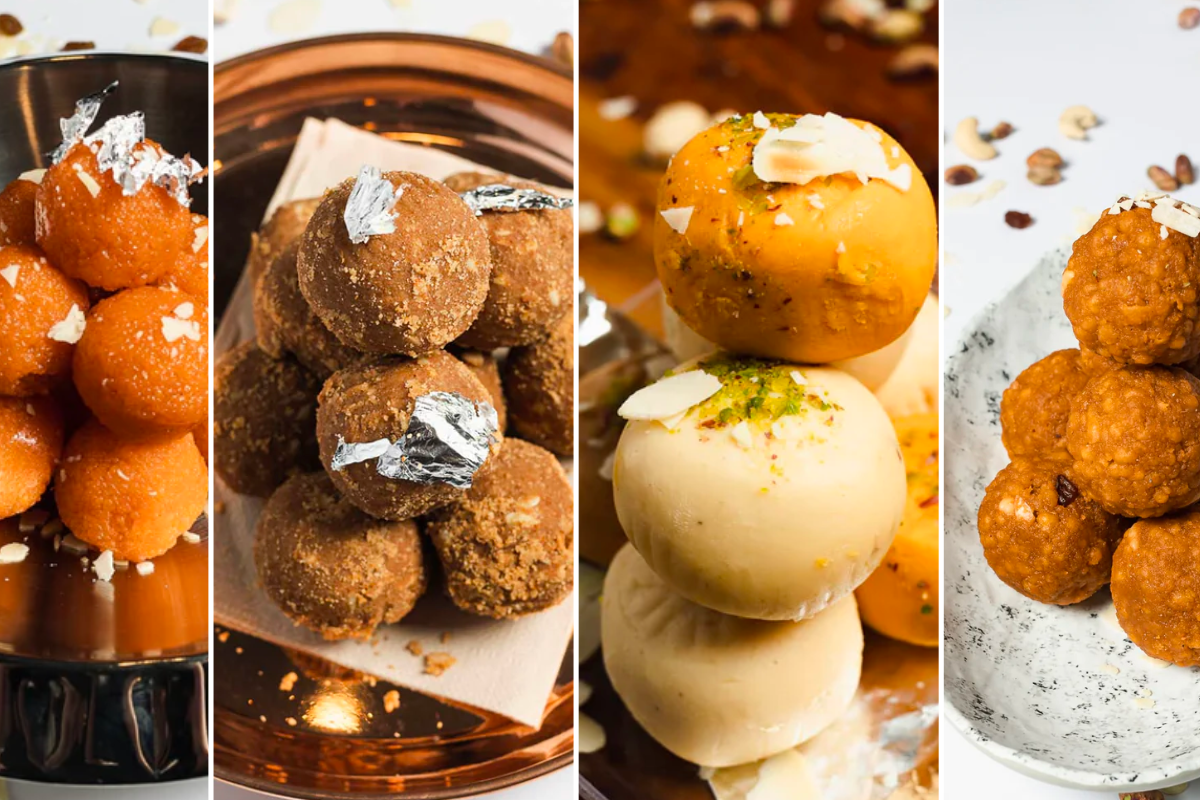
During Ganesh Chaturthi celebrations, several delectable sweets are offered as prasadam, each with its unique characteristics and flavours. Here is a brief description of these special prasadam items:
1. Motichoor Ladoo:
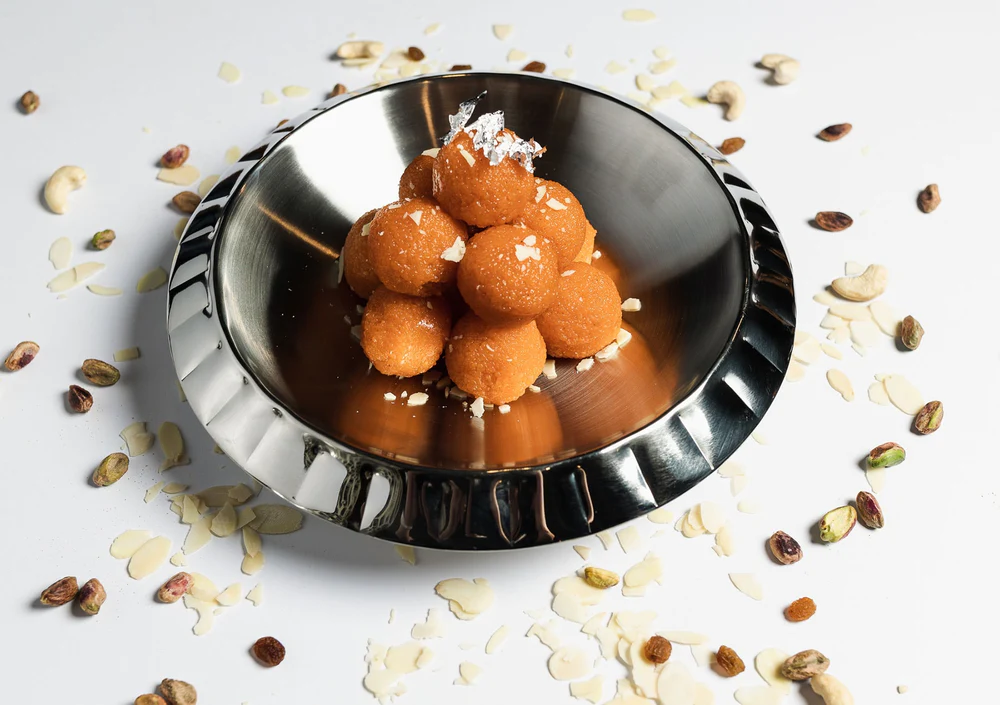
-
Unique Characteristics: Motichoor ladoo is made from tiny, deep-fried gram flour (besan) droplets that are shaped into round balls. These droplets are small and have a slightly granulated texture, resembling pearls, which gives the sweet its name "motichoor" (meaning "pearl-like").
-
Flavour: Motichoor ladoo has a delightful balance of sweetness and nutty flavours. The fried gram flour imparts a rich and slightly crispy texture, while the sweetness is complemented by aromatic cardamom and saffron flavours.
2. Besan Ladoo:
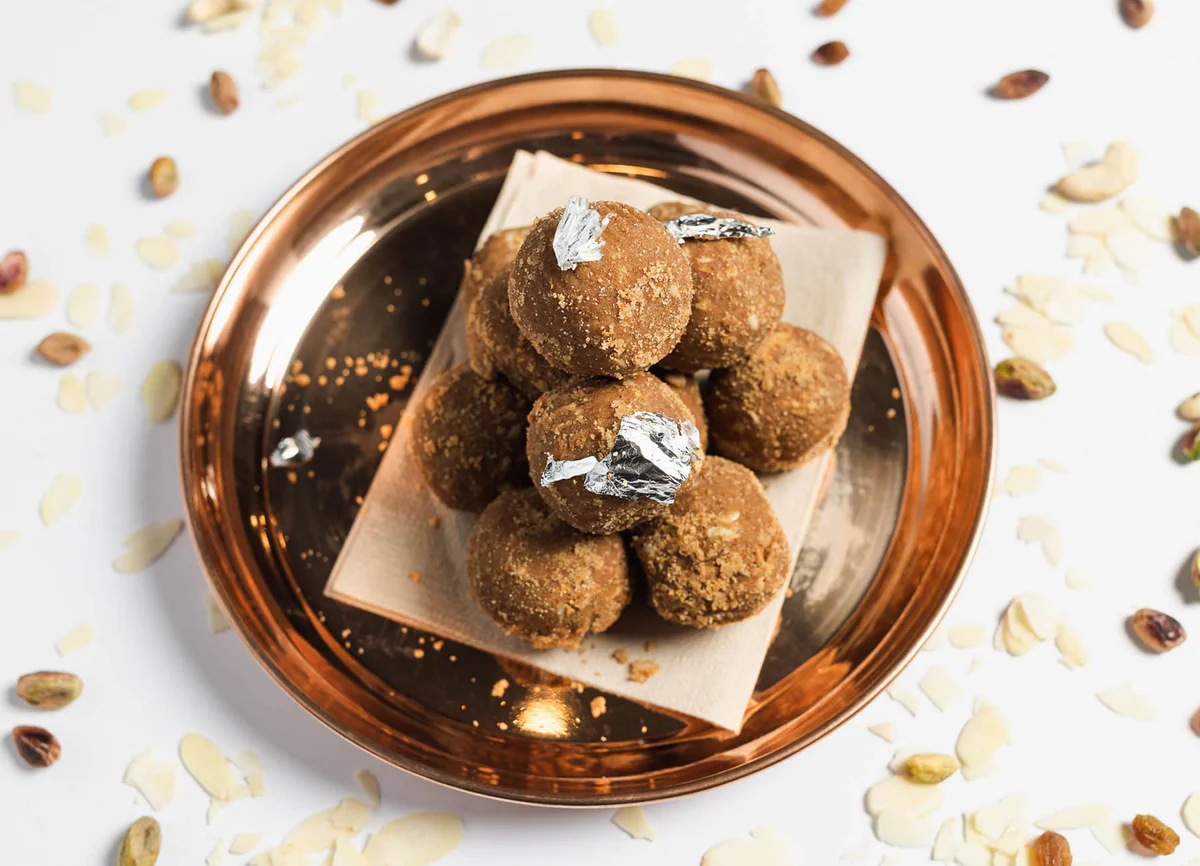
-
Unique Characteristics: Besan ladoo is made from roasted gram flour (besan) mixed with ghee (clarified butter) and sugar. It is shaped into small, round balls that are easy to handle and serve.
-
Flavour: These ladoos have a rich and nutty flavour due to the roasted gram flour and ghee. They are often garnished with chopped nuts like almonds or cashews, adding a delightful crunch and extra flavour.
3. Mixed Peda:
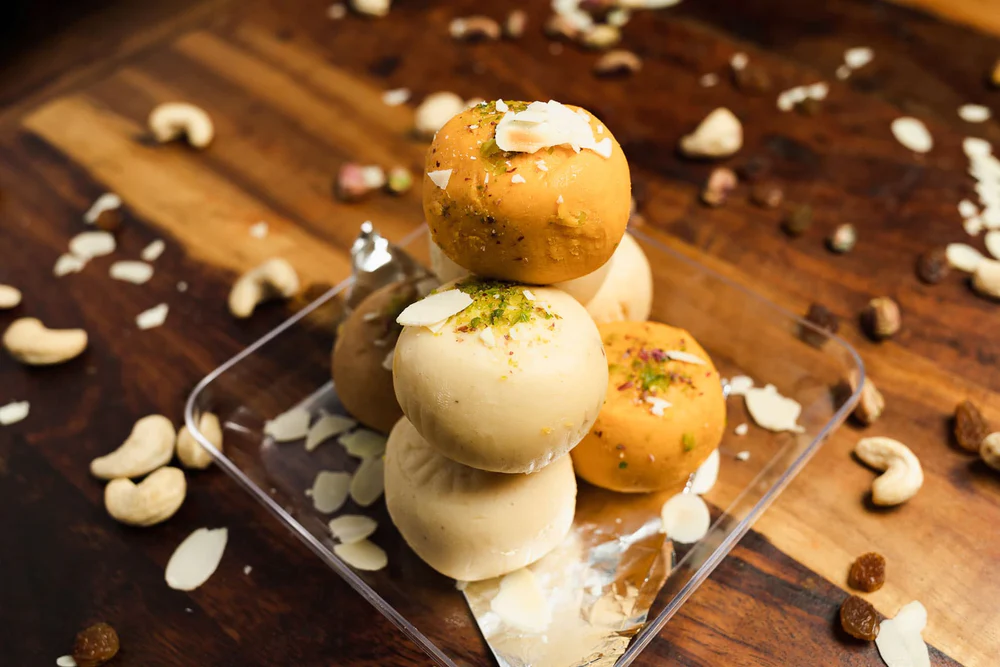
-
Unique Characteristics: Mixed peda is a combination of various flavours and textures. It is typically made from condensed milk, flavoured with ingredients like cardamom, saffron, and pistachios, and moulded into small, flat, round shapes.
-
Flavour: Mixed peda offers a delightful blend of creamy sweetness with the aromatic notes of cardamom and saffron. The addition of pistachios not only enhances the flavour but also adds a colourful and appealing touch.
4. Anamaya Ladoo:

-
Unique Characteristics: Anamaya ladoo is a traditional Indian sweet that combines the goodness of whole wheat flour, jaggery (unrefined cane sugar), and ghee. It is formed into small, dense round balls.
-
Flavour: Anamaya ladoo has a rustic and earthy flavour due to the use of whole wheat flour and jaggery. It offers a satisfying sweetness, enhanced by the nutty richness of ghee.
5. Boondi Ladoo:
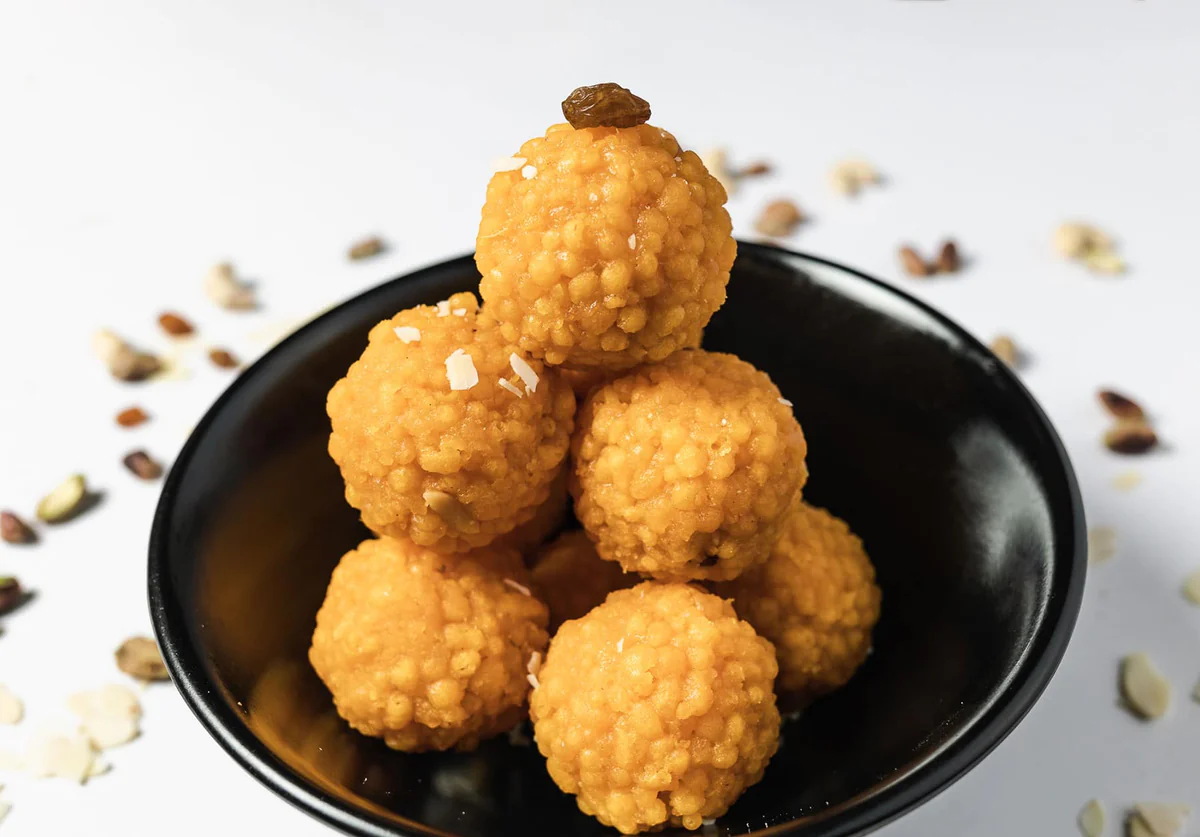
-
Unique Characteristics: Boondi ladoo consists of small, round droplets made from gram flour batter, which are then soaked in sugar syrup and shaped into round ladoos.
-
Flavour: Boondi ladoo has a unique combination of sweet and slightly tangy flavours due to the sugar syrup. The boondi, with its porous texture, absorbs the syrup, creating a sweet and syrupy delight.
These prasadam items not only serve as offerings to Lord Ganesha but also delight the taste buds of devotees and guests during the festival. Each sweet dish has its own charm and adds to the festive spirit of Ganesh Chaturthi celebrations.
Conclusion
In conclusion, Ganesh Chaturthi is a deeply cherished and significant Hindu festival celebrated with great devotion and enthusiasm. It encapsulates a beautiful tapestry of rituals and traditions, each contributing to the vibrant and spiritual atmosphere of the auspicious occasion itself.
As we celebrate Ganesh Chaturthi, let us remember that this festival is not just a religious observance but also a cultural heritage that unites communities and families. It is an opportunity to embrace traditions that have been passed down through generations, to come together in prayer and celebration, and to share the joys of devotion with loved ones.
As you prepare to celebrate the joyous festival of Ganesh Chaturthi, we invite you to explore the delectable range of Indian sweets offered by Swagath Foods. Our collection includes a delightful array of traditional sweets, perfect for enhancing your Ganesh Chaturthi festivities.
Discover the rich flavours, spices and authentic taste of our sweets, carefully crafted to capture the essence of Indian traditions. Whether you're seeking the sweetness of Motichoor Ladoo, the nutty richness of Besan Ladoo, the aromatic blend of Mixed Peda, the rustic charm of Anamaya Ladoo, or the unique texture of Boondi Ladoo, Swagath Foods has something to delight every palate.
To make your Ganesh Chaturthi celebrations even more special, explore our wide selection of sweets, nuts and spices and treat yourself, your family, and your friends to these exquisite offerings. It's the perfect way to add a touch of sweetness to your festivities and share the blessings of the season.
For more information and to explore our range of Indian sweets, please visit the Swagath Foods website. We look forward to being a part of your cherished celebrations and sweetening your moments of joy with the authentic taste of tradition.
Ganpati Bappa Morya!










